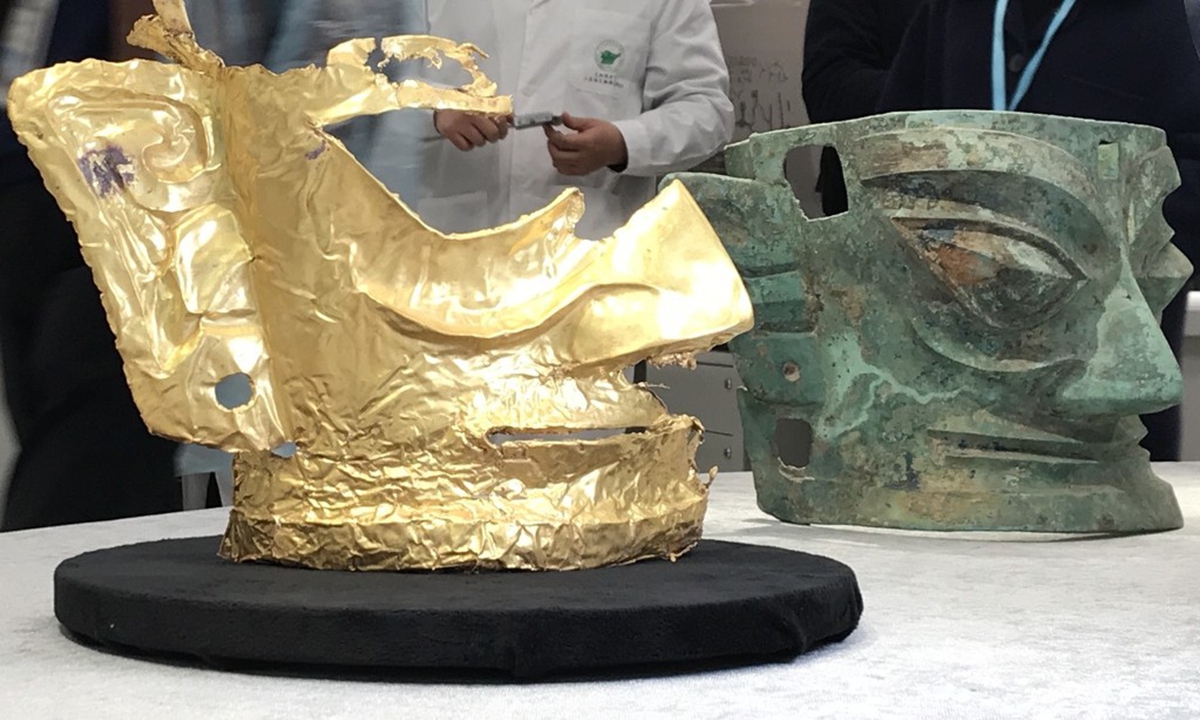Gold mask among 500 relics found in prehistoric Sanxingdui Ruins; discoveries to shed light on China’s cultural origin

Photo: IC
Six more ancient sacrificial pits and more than 500 relics dating back to about 3,000 years have been unearthed at the renowned Sanxingdui Ruins site in Southwest China’s Sichuan Province, the National Cultural Heritage Administration announced in Chengdu on Saturday.
"It has been confirmed that Sanxingdui Ruins site is the oldest site of pre-Qin period (pre-221 BC) in the upper reaches of the Yangtze River," according to Lei Yu, head of the excavation team at the Sanxingdui site. Experts believe that the new findings at the site will shed more light on the ancient Shu civilization and its link to the civilization of the Chinese nation.
Among the relics, there are pieces of exquisite gold masks, gold foil, bronze masks, bronze sacred trees, ivories, ivory products and jade.
A fragment of a gold mask found in one of the pit has surprised the archaeologists with its larger size compared to previous archaeological findings. It is about 23cm wide and 28cm high and weighs about 280 grams. Preliminary inspection by archaeologists shows that the mask contains about 84 percent gold.
It is evaluated that the whole gold mask could weigh more than 500 grams, said Lei. He believes that if a complete golden mask can be found, it will not only be the largest and heaviest gold mask object of the same period ever found in China, but also the heaviest gold object from the same period.
The excavation also found traces of decayed silk from the site, it’s the first time that silk dating back to more than 3,000 years ago has been found in the province. Silk protein has been detected multiple times in sample soil tests, proving that silk was already used in the Sanxingdui kingdom more than 3,000 years ago.
"Such findings will help us understand why Sichuan became an important source of goods for the Silk Road after the Western Han Dynasty (206BC-AD25)," an expert said.
Notably, all these precious items were retrieved from six rectangular pits newly found in the Sanxingdui Ruins from November 2019 to May 2020.
With areas ranging between 3.5 square meters and 19 square meters, the pits were found next to another two discovered in the ancient city in 1986. The whole complex was used by ancient people to offer sacrifices to their ancestors, the heaven and the earth, and pray for prosperity.
Around the eight pits there are also small circular pits, grooves and large grooves related to sacrificial activities.
Sun Hua, a professor from Peking University, said during a livestreaming press conference that the discoveries and researches will help reconstruct the interior space of a possible god temple on the site, understand the sacrificial scenes, religious thought and even the concept about the universe at the time.
This round of excavation started in November 2019, following a previous one 34 years ago when more than 1,000 pieces of relics were unearthed in two pits, such as bronze gods, bronze statues, bronze sacred trees, golden masks, golden sticks, jades and ivory. Most of the relics were new to the world at that time.
According to Lei, preliminary investigation shows that the whole site is made up of three layers from inside to outside, separated by three city walls which are believed to have been built in different ages. The first layer inside is Yueliangwan Small City distributed with large-scale construction, worship places and suspected areas of handicraft workshops, the second is a residential area, and the third is a sacrificial area.
So far, only some symbols were found on unearthed potteries, an expert said. He believes that written characters had been used in Sanxingdui, which needs further excavation and research to prove.
Located in Sanxingdui township of Sichuan Province, the Sanxingdui Ruins site stands on the south bank of the Jianjiang River (Yazi River), a tributary of the Tuojiang River in the north of the Chengdu Plain. The site covers an area of about 12 square kilometers. Its core area, Sanxingdui Ancient City, covers an area of about 3.6 square kilometers.
The site was first discovered in the late 1920s. It is the largest and highest ranking centralized site ever found in Sichuan Basin which could date back to Xia (c.2070BC-c.1600BC) and Shang (c.1600BC–1046BC) dynasties.
